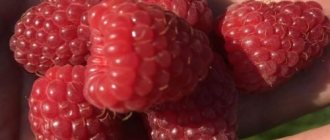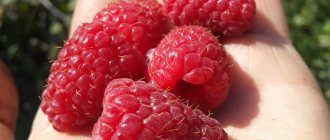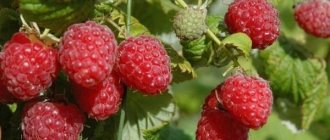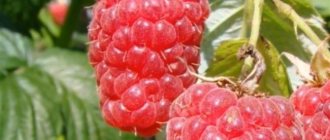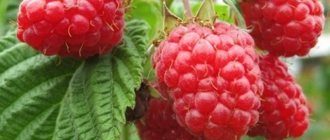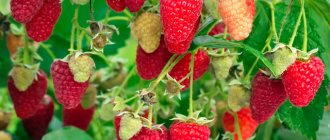Raspberry variety Daughter of Hercules is a new variety obtained from the remontant raspberry Hercules. It has inherited a lot of advantages from its parent variety and has many common characteristics with Hercules: characteristics of the growth and structure of the bush, taste and size of the fruit, but there are also some differences.
Description of the variety
The Daughter of Hercules is a powerful, medium-sized shrub, characterized by a tendency to branch. Compared to the parent variety, it has more spreading bushes that require obligatory gartering to a support.
The bushes produce few offspring, only 2-4 shoots, which facilitates the process of caring for raspberries.
The thorny, erect, thick stems reach a height of at least 2 m. The hardy shoots do not bend too much under the heavy weight of a large number of large berries. But, despite this advantage, it is still advisable to install trellises in the raspberry garden to help the bushes and make it easier to care for the crop.
During the season, the stems of the Daughter of Hercules raspberries change color. If in the spring they have a rich green color, then by autumn they become bright cherry. This feature is not a sign of a crop disease.
The variety is distinguished by its unpretentiousness to soil composition and climatic conditions. Seedlings take root very quickly. When planting the Daughter of Hercules in the spring, already at the beginning of autumn, you can harvest the first harvest and evaluate the taste of the fruit.
The berries ripen in waves. The minimum period between collections is 3-4 days. Abundant raspberry fruiting begins in August and continues until the first frost (October).
In regions with a harsh climate, during the second fruiting, not all berries have time to ripen. But gardeners have found a way out: fruit branches with unripe fruits can be cut off and placed in a small container with water. Raspberries ripen quite quickly at home, and after a few days you can harvest the last harvest.
The variety is characterized by high resistance to many diseases and is extremely rarely affected by pests, which is the reason for the great popularity of the Daughter of Hercules among gardeners.
You might be interested! Description of one of the largest-fruited varieties (berries up to 10-12 g) among the remontant varieties - Atlant raspberry.
Raspberries also have high frost resistance. But in winters with little snow and when growing crops in regions where frosts of –25˚С –30˚С are not uncommon, it is still advisable to provide the plants with shelter. Proper pruning of raspberry bushes in the autumn also helps to survive harsh winters.
Raspberry variety "Hercules"
Description of the variety
The name of the variety speaks for itself. The main advantage of this variety of raspberries is the impressive size of the berries (from 9 to 15 g). The fruits of the crop have a high density, rich red color and a truncated cone shape.
The taste is sweet, pleasant, with a slight sourness. The “Hercules” variety is remontant; accordingly, already in the first year it is ready to please the gardener with a good harvest. Another advantage of the variety is its low susceptibility to pests and diseases.
Main external characteristics of the variety:
- the average height of the bush is up to 2 m;
- strong, erect trunk;
- richly colored green leaves;
- greenish tint of the current year's shoots, brown - two-year-old shoots;
- sharp thorns on the stem.
The berries of the “Hercules” variety ripen at the end of summer, and fruiting lasts until frost. If agrotechnical practices are followed, the bush produces a harvest 3 times, the last one in the fall. The main disadvantages of the variety are poor formation of shoots and an extended fruiting period, as a result of which the last harvest often does not have time to ripen.
Features of planting and care
The yield and properties of berries largely depend on the location where the shrub is planted. Raspberries love light and are afraid of drafts, so most often they are planted along fences on the south side of the site. The crop prefers light soil with good drainage; The best option would be loamy or sandy soil with a fertile top layer.
Raspberries are planted in the spring, having previously prepared the soil before planting (the selected area is dug up, fertilizers are applied, and weeds are removed). The shrub is propagated by woody cuttings with an already developed root system. A hole up to half a meter in diameter and about 45 cm deep is dug under the seedling. After the raspberries are planted, it is recommended to water the soil and sprinkle it with peat or sawdust (mulch). In dry areas, it is recommended to make shallow trenches around the trunk. This way, rainwater will stay in the root zone longer.
Plant care includes the following activities:
- The soil is periodically loosened and cleared of weeds, and mulched.
- In the spring, raspberries are fed with chemical fertilizers, and in the summer it will be useful to water the bushes with decoctions of nettles and other herbs; you can use a low concentration solution of bird droppings.
- To prevent the branches from breaking, supports are built for the raspberries, the design of which can be varied.
- Before winter, the root zone of the shrub is covered with a thicker layer of mulch, and the shoots are bent to the ground.
- In the second year of life, raspberries need to be pruned. In the spring, the tops of young shoots (about 12 cm), as well as frozen and dried stems, are cut off. In the fall, the bush is thinned out and cuttings that have stopped bearing fruit are cut out at the root.
Raspberries are a perennial shrub, but growing them in one place for a long time deteriorates the quality of the berries, and the bush degenerates. In view of this, every eight to ten years the raspberries should be moved to a new place.
Reviews about the variety
Gardeners like remontant raspberries “Hercules” because of their excellent taste and good fruiting. The large size of the berries and the high productivity of the plant are noted - up to 3 kg of raspberries can be obtained from one bush. The remontant variety produces a harvest already in the first year.
Description of fruits
The berries of the raspberry variety Daughter of Hercules are large, dense and very beautiful. On average, their weight ranges from 10-20 grams. The shape of the fruit looks like a truncated cone, the color is dark red. Raspberry Daughter of Hercules has a sweet taste with a slight sourness and a delicate aroma.
The versatility of using ripe fruits involves not only eating raspberries fresh, but also for preparing various jams, preserves, and compotes. The taste of the berries is rated 4 out of five on a tasting scale, which is considered a fairly high result for raspberries.
The drupes are connected to each other very tightly, and due to this feature, ripe raspberries tolerate transportation well without loss of presentation and quality.
The yield of the Daughter of Hercules is truly amazing - from one bush, if you follow the growing rules, you can harvest up to 8-10 kg. delicious dense berries.
The fruits of this raspberry variety can withstand low temperatures very well. Quick freezing will help provide your family with fresh berries throughout the winter. After defrosting, the fruits keep their shape well and the taste characteristics do not change.
Harvesting and transportation
Ripe berries are harvested as they ripen, after they acquire their characteristic shade and juiciness. This is done manually; only in this case can damage to the berries be avoided and they have good shelf life. The fruits are selected into small containers, from which they are carefully transferred to common buckets or other containers.
If the harvesting process is carried out correctly, the harvest of the Daughter of Hercules variety is characterized by excellent shelf life and transportability, so such berries are ideal for long-term transportation with subsequent sale. This is achieved by reducing the wateriness of the berry, which gives the fruit tissue elasticity and mechanical resistance to damage.
Find out how to properly freeze raspberries for the winter.
The daughter of Hercules can be confidently called the successor to the more popular and famous raspberry variety Hercules. This plant has excellent productivity and is also relatively unpretentious to living conditions, so the hybrid can be cultivated in almost any climatic region. This makes it possible to easily obtain an excellent harvest, worthy only of the highest reviews.
Advantages and disadvantages
Breeders believe that there are no ideal varieties of fruit and berry crops. Each has both advantages and some disadvantages, which it is advisable to find out before purchasing seedlings.
Benefits of Daughter of Hercules:
- rapid rooting of shoots;
- ease of care;
- not demanding on soil composition;
- shoot formation is low, only 2-4 shoots, which makes it possible to eliminate the process of thinning the raspberry tree;
- the berries ripen on the bushes within a few months after planting;
- remontability of the variety, which determines the yield of one-year and two-year shoots;
- long fruiting period;
- large, dense fruits;
- raspberries tolerate transportation well without loss of presentation and taste;
- commercial component - The Daughter of Hercules produces two harvests a year;
- frost resistance and high resistance to diseases and pests.
The variety has several disadvantages:
- Many gardeners in their reviews indicate that the Daughter of Hercules is characterized by a sourish taste of the fruit. However, not everyone takes into account this feature of taste characteristics, since everyone’s preferences are different. For some, a slight sourness, on the contrary, will be a big plus. This “flaw” is of no small importance for winemakers.
- The thorny stems make harvesting difficult.
- Secondly, the Daughter of Hercules begins to bear fruit late, and not all the berries have time to ripen.
As you can see, almost all the shortcomings can be considered conditional, which suggests that the remontant raspberry variety Daughter of Hercules is perfect for growing in personal plots.
Properties and characteristics of the plant
The raspberry variety “Hercules” is remontant, productive, and large-fruited. The bushes are compact, the activity of shoot formation is moderate. The stems are of medium height (up to 180-200 cm), straight, strong, not prone to lodging and do not need support. There are many thorns, they are located along the entire length of the shoots. The leaves are green, large, without pubescence.
The bushes are compact, the stems are erect, strong, do not lie to the ground under the weight of berries and do not require support
Characteristics of berries
The berries are bright red, in the shape of a wide cone with blunt tips, dense, large, with a classic “raspberry” aroma. The average weight is about 10 g, the largest ones can weigh up to 15 g. The yield is high: with good care, each plant produces up to 3-4 kg of berries per season. The fruits tolerate short-term storage and transportation well, and retain their shape during heat treatment (in compote or jam). The purpose is universal.
The berries have an attractive presentation and large size, suitable for fresh consumption and all types of processing.
According to the originator, the berries contain:
| Nutrients and beneficial substances | Quantity |
| Sahara | 9,8% |
| Acids | 1,3% |
| Vitamin C | 32 mg% |
There is no clear opinion about the taste of the berries of this variety. Officially, it is rated 4 points (out of 5), and many consumers consider it not too sophisticated, but quite worthy. However, the quality of Hercules raspberry fruits, according to gardeners, very much depends on parameters such as soil composition and climatic characteristics of the growing region.
When planting on “poor” soils, it is necessary to apply a large portion of organic fertilizers to each seedling, and feed the bushes in the spring and several times during the season. Without this, the berries become smaller and become tasteless, acquiring excess sourness. In areas with cool and damp summers, raspberry fruits are large and beautiful, but watery and almost tasteless. In the southern regions, Hercules raspberries ripen sweet, although not so sweet as to compete with many more sugary varieties.
Photos from sites offering planting material for raspberries of the Hercules variety
Advantages of the variety
Nevertheless, this type of popular culture has a number of undoubted advantages. One of the most important is the possibility of obtaining a harvest in the “raspberry off-season”. This is what berry growers call the period in mid-summer, when the earliest varieties have already finished bearing fruit, and the later ones have not yet ripened. Raspberries “Hercules” when cultivated as an annual crop (that is, with radical pruning of bushes in the fall and summer fruiting “in one wave”) begins to ripen a little earlier than other remontant varieties. In this case, ripe berries are harvested already in mid-July, thereby making up for the temporary shortage of raspberries on the market. This property of the variety is also useful for summer residents, especially those who cultivate several varieties of crops that have different ripening periods.
Cultivation of the variety as an annual crop involves radical pruning of bushes in the fall
Among the other advantages of the variety, it is worth noting the following:
- unpretentiousness . Raspberries tolerate temperature fluctuations and short-term droughts well. On most soils (except for the “leanest”) it does not require abundant fertilizing;
- ease of care . The bushes are low and can be grown without trellises. Few root shoots are formed. There are enough new shoots to reproduce, but the plantings do not thicken. With radical autumn pruning, protection from frost is not required (except, perhaps, mulching in case of severe frosts in the absence of snow);
- resistance to diseases and low susceptibility to pests;
- large-fruited;
- the versatility of using berries, their suitability for transportation;
- yield , which is assessed as consistently high.
Specifics of cultivation
Most of the shortcomings of the Hercules raspberry are associated not so much with the qualities of the plant itself, but with attempts to cultivate it in not entirely suitable conditions. To be fair, gardeners can only complain about the strong thorniness of the shoots, which really interferes with raspberry cultivation and harvesting.
The disadvantages of the variety include strong thorniness along the entire length of the shoots, which makes caring for plants and harvesting difficult.
The variety is initially not recommended for cultivation in regions with cool and short summers, and for good reason: the fruiting period of remontant raspberries is greatly extended, berries set at the end of summer do not have time to ripen even when cultivated as an annual crop. If a summer resident tries to get two harvests in a season, in addition to this problem, he is faced with others: the need to cover last year’s shoots for the winter and damage to the flower buds that form on them, which are often subject to spring frosts. In general, the variety can be considered quite worthy, but it is better to cultivate it in the southern regions. In this case, the gardener can freely choose the method of pruning the bushes and the mode of their fruiting.
Landing rules
Before planting the Daughter of Hercules raspberries, it is necessary to carry out a number of preparatory work, which will be the key to a high harvest in the future.
Selecting a suitable site
The daughter of Hercules does not make any special demands on the composition of the soil. However, for its cultivation and abundant fruiting, it is necessary to select an area that is maximally illuminated by the sun’s rays and protected from drafts and piercing winds.
With a lack of lighting, remontant raspberries increase the period of flowering, formation and ripening of berries. The taste characteristics of the fruit also decrease: the berries become sour and watery, and lose density.
Heavy, clayey and sandy soils, as well as places with high groundwater levels, are undesirable for planting varieties. In waterlogged soil, the root system begins to rot, which affects the condition of the entire plant, and disease resistance decreases.
Soil preparation
It is recommended to plant a remontant raspberry variety in the autumn, but spring planting is not excluded. Before starting such an important event, the selected area is carefully dug up, having first added to the soil per 1 m²: superphosphate - 65 g, humus or humus - 13-15 kg, potassium sulfate - 45 g. In the process of preparing the soil for the future raspberry garden It is necessary to carefully select all weeds and roots.
Recommended landing scheme and algorithm
You can plant the Daughter of Hercules, like all remontant varieties, in several ways:
- In trenches, the depth of which is at least 0.5 m. Planting of seedlings is carried out in increments of 0.7-0.9 m. The minimum row spacing is 1.5-2 m. This method allows you to prevent subsequent thickening of the raspberry tree, and each bush will be sufficiently illuminated.
- Curtinny. Raspberries are planted in groups of 3-4 seedlings at a distance of 60-70 cm from each other.
- Triangular. Seedlings are planted at the corners of an equilateral triangle at intervals of 0.5 m.
Whatever method is used, it is advisable to follow the recommendations regarding the distance between seedlings, planting depth and row spacing.
The landing algorithm looks like this:
- fill the trenches or planting holes prepared in advance 1/4 with fertile soil;
- Carefully place the root system of the seedlings in the hole;
- fill the planting hole and lightly, without fanaticism, compact the soil;
- Water generously and cut the shoots at a height of 25-30 cm.
At this point, the process of planting remontant raspberries can be considered complete.
Features of agricultural technology
To get high yields on your plot, you should spend a lot of effort. To do this, you need to choose the right place for planting, and also surround the young bushes with specific care. Only in this case can you get aromatic raspberries that are not subject to any damage or pathologies.
You will be interested to know why raspberry leaves turn yellow.
Selecting a location
To choose the best place to grow a fruitful bush, the gardener should remember that raspberries love an abundance of heat and light, and also cannot tolerate drafts and excessive humidity. It follows from this that the plant must be planted in open and well-lit areas, at least 3 m from any tall vegetation. The place for the raspberry bush should be located on a hill, near low garden barriers or a fence, which will protect the bushes from high humidity and possible drafts.
In addition, the ideal site for planting should have the following characteristics:
- high level of groundwater;
- have previous crops such as potatoes, tomatoes, bell peppers and eggplants;
- be located on well-fertilized loamy or sandy loam soil.
Planting and care
Planting of bushes begins in the fall, in the first half of October. To do this, about 2 weeks before planting, the area is cleared of weeds and remnants of other vegetation and plowed well to a depth of at least 30 cm. Before plowing, the soil must be fertilized. To do this, add 10–15 kg of humus, 65 g of superphosphate and 45 g of potassium sulfate per 1 m².
Important! The raspberries are planted in the same place no earlier than every 5 years. Otherwise, the seedlings will take root with difficulty, and young plants will constantly get sick and bear fruit poorly.
If vegetables are grown on the site of the beds all season, around August the area needs to be dug up and then sown with clover or other legumes. The resulting mass should be mowed before plowing and applied as a natural fertilizer.
Raspberries are planted to a depth of about 50 cm according to one of the following schemes:
- curtain - bushes are planted in small groups of 3 plants at a distance of 60 cm;
- triangular — one or several triangles with a length of each side of about 50 cm are divided on the site. Raspberries are planted on the edges of each triangle, 1 plant;
- square — the beds are divided into uniform squares with sides of 100–150 cm. One bush is placed in each of them;
- tape — the plot is divided into parallel rows with row spacing of about 150–200 cm. In the rows, bushes are planted evenly every 70–90 cm.
After planting, the seedlings are watered abundantly and left alone. Immediately before winter frosts, the bushes are mulched to prevent freezing. After the onset of a full spring thaw, young plants are subjected to standard care. First of all, the seedlings are provided with a regular watering system.
Subsequent care of the crop
Every gardener knows perfectly well that not only their future productivity, but also the condition of the plants, as well as the preservation of varietal characteristics, depends on how competently and timely care is provided for fruit and berry crops.
Caring for a remontant raspberry variety consists of performing the following activities:
- watering and loosening;
- mulching;
- feeding;
- proper pruning of raspberry shoots;
- preparation for winter.
Watering and loosening
For good development of shoots, you need to water the raspberry tree regularly. It is especially important to moisten the soil during periods of drought, as well as when the plant enters the phase of flowering, formation and ripening of fruits.
During the watering process, you need to ensure that there is no stagnation of moisture for a long period, so as not to cause an outbreak of disease in the root system. After heavy watering or heavy rain, you need to regularly loosen the soil under the raspberry bushes, but no more than 8-10 cm.
Mulching
To avoid unnecessary hassle with weeding and loosening, you can mulch the soil 1.5-2 weeks after planting. This procedure will help avoid overheating of the roots on hot days and retain moisture. Suitable materials for mulch include:
- straw;
- chopped tree bark;
- peat;
- sawdust.
In the fall, when preparing the raspberry tree for winter, the mulch layer needs to be updated.
Top dressing
They begin to feed the Daughter of Hercules variety from the second year after planting. In spring and early summer, raspberries are fertilized with mineral fertilizers. For active shoot growth at the beginning of the growing season, the crop urgently needs nitrogen. You can compensate for the deficiency of this element with the help of urea, infusion of bird droppings or infusion of mullein.
At the end of summer, before the start of the second fruiting, raspberries are fed with complex fertilizers. In autumn, the crop must be fertilized with superphosphate and potassium (at the rate of 1 tsp of dry granules per bush).
Pruning and preparation for winter
Trim the Daughter of Hercules raspberries at a height of 6-8 branches and tie the shoots to the trellises. Also, in early spring, while the buds have not yet swelled, it is advisable to clear the raspberry tree of frozen, damaged shoots and debris. In autumn, all fruit-bearing shoots are removed. Leave annual stems - they will give a bountiful harvest next year.
It is imperative to bend and cover the shoots. Despite the fact that the variety is frost-resistant, it is impossible to predict what frosts there will be and how much snow will fall. Therefore, take all measures to preserve raspberries and help them survive the winter cold.
Planting bushes
Planting and caring for raspberries “Hercules” will not be difficult for an experienced gardener, however, we will remind both them and novice lovers of berry bushes about some of the features of the agricultural technology of this crop.
- Planting in holes or trenches at intervals of 70 centimeters, 1.5 meters between rows.
- For planting, you need to choose a sunny, dry place. This variety does not tolerate shade, which causes the berries to become smaller and lose their sweetness.
- Before planting, it is necessary to fill the trenches with organic matter. Remember that the variety is a giant variety and therefore requires increased nutrition. It’s a good idea to add a handful of ash per meter of trench.
- After planting, it is necessary to thoroughly mulch the soil with nutritious organic matter: leaf litter, manure, and mown grass.
- It is necessary to carry out proper pruning of bushes.
Reviews
I chose raspberries based on reviews from gardeners, so I decided to write a review myself, in case for someone it will be decisive in choosing a variety. I live in the Urals and was looking for remontant raspberries that could survive our frosts, I read reviews, one of the gardeners in Ufa was cultivating this variety, I also decided to buy several seedlings to try. Several years have passed and I can objectively evaluate what I have achieved. The daughter of Hercules pleases with its productivity - there are enough berries for jam and to eat fresh, it winters well - I actively covered it the first year, and now I’m just bending it down, but I have a raspberry tree in a place where there’s always a lot of snow, maybe that’s the problem in that. The berries are large, do not wrinkle, I make wine from them with strawberry yeast, I like the resulting fragrant and sour taste. The second autumn harvest allows you to enjoy raspberries at the end of the year. I get apples and raspberries in September. The neighbors ran out of raspberries a long time ago, but my grandchildren continue to eat them. In general, I like the variety and will continue to cultivate it.
The remontant raspberry variety Daughter of Hercules is a high-yielding and unpretentious plant. Therefore, many gardeners, not paying attention to minor shortcomings, are increasingly choosing it for their plots, wanting to fully enjoy the unique taste of aromatic berries.
Reviews from gardeners
Anna, 45 years old, Irkutsk
The remontant raspberry variety Daughter of Hercules is considered one of the best in its area. The dark red fruits are shaped like a truncated cone and have a sweet and sour taste. I collect up to 3 kg of raspberries from a bush, which is a very good harvest. The variety does not require special growing conditions. For two years, no diseases were found on the bushes. The bushes are erect and do not bend under the berries, but they need to be tied up. Raspberries produce a lot of offspring, so I easily planted another row with them.
Vladimir, 48 years old, Moscow region
Before choosing plants for the garden, we carefully studied the description of the raspberry variety Daughter of Hercules, photos, reviews on the Internet. We purchased small sprouts at a local fair. First, we planted the raspberries in tall glasses intended for seedlings. The variety was well accepted and began to grow. At the beginning of June, we planted raspberries in planting holes and added humus and fertile soil. The replanting did not have any negative impact on the plants. In the fall, the variety began to bloom, and before the cold weather we had time to appreciate the taste of the berries. The next year we got a good harvest; the berries ripen consistently and can be picked every three days.
Alexey, 40 years old, Ekaterinburg
Repair raspberries Daughter of Hercules were planted at my parents' dacha. When we first saw its ripe berries, we were amazed at their size. The fruits turned out to be large, dense and sweet. At the same time, many flowers and green berries remained on the bushes. Raspberries were planted in trenches 0.5 m deep. When planting, humus, ash and superphosphate were added to the pit. The raspberries were planted, the soil was compacted tightly and watered. Subsequently, the plants were only watered. Three stems were left for each square meter, the rest of the growth was removed.
Description of the remontant raspberry variety Daughter of Hercules
Daughter of Hercules is a relatively young remontant variety. It is considered an improved variation of the Hercules variety.
Raspberry Hercules and Daughter of Hercules have the same description. However, the improved version is characterized by increased winter hardiness and disease resistance. Also, the Daughter of Hercules branches more strongly than Hercules, and has even larger fruits.
Main characteristics
Raspberry Daughter of Hercules is popular with both experienced and novice gardeners. The plant has excellent characteristics that allow it to be grown in most regions of our country.
Description of raspberry Daughter of Hercules:
- The bush is medium spreading. Every year it forms from 2 to 5 shoots. This makes it easier to form. The branches are powerful and do not break under the weight of the fruit. The height reaches 2 m. The stems are erect, covered with long thorns. At the beginning of summer, young shoots have a green tint, but by autumn they turn red.
- The leaf blade is medium-sized, dissected. The color is bright green. The bush is abundantly leafy.
- The fruits are large. The weight of one berry is 10-20 g. They have an oval or ovoid shape. Dense, juicy, but not watery. When ripe they have a dark red hue. Unripe fruits are green or brown. They have a pronounced raspberry aroma. The taste is delicate, sweet with a slight sourness. Suitable for fresh consumption and preservation.
- The yield is high - up to 10 kg of berries per harvest from a bush. The Daughter of Hercules gives it twice during the season.
- In terms of ripening, the variety is late-ripening. The fruits are harvested from August to October.
- Transportability is high. Dense, strong fruits do not wrinkle during transportation.
Features of the variety
The daughter of Hercules is famous not only for its large berries. The variety has a number of other features:
- Immunity. It is resistant to viral and fungal diseases. The plant is rarely attacked by pests.
- Frost resistance. Tolerates cold winters well. Due to its late ripening, it is suitable for cultivation in the southern and central, but not in the northern regions.
- Maintenance. Fruits are formed on the shoots of the previous and current year. The first berries are formed already in the year of planting.
- It requires light, so it is planted only in well-lit areas.
- Demanding on humidity. But with high humidity, the shoots rot.
In the central regions, berries from the second harvest do not always have time to ripen before frost. In this case, the shoots with fruits are cut off and placed in water at room temperature. After a few days they ripen.

